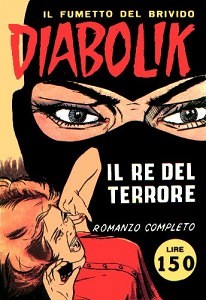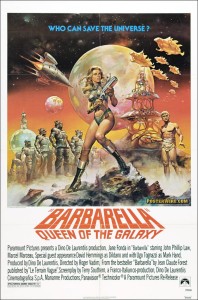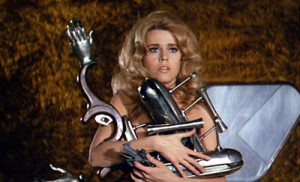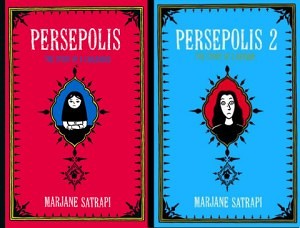In a multi-part series, Comic Book Film Editor William Gatevackes will be tracing the history of comic book movies from the earliest days of the film serials to today’s big blockbusters and beyond. Along with the history lesson, Bill will be covering some of the most prominent comic book films over the years and why they were so special. This time, we begin our four week “vacation” overseas with the most notable one-off comic films Europe has to offer.
Comic books are a uniquely American art form, but this doesn’t mean that they aren’t popular in other parts of the world. Europe and Asia have come to embrace the comic medium over the decades. As a matter of fact, they have been quicker to see the artistic merits of comic books than we here in the United States were. While Americans were considering comic books cheap entertainment for kids and emotionally stunted adults, people overseas were using the medium to expose on sexuality, politics and philosophy.
 To cover every foreign comic book film would take up too many weeks in this here rundown, so we will be covering some of the films that have the most name value here in the States, either in their comic book form or in their film adaptation. This means that there will be a lot of great comic book films left out in these four weeks. And for that I apologize.
To cover every foreign comic book film would take up too many weeks in this here rundown, so we will be covering some of the films that have the most name value here in the States, either in their comic book form or in their film adaptation. This means that there will be a lot of great comic book films left out in these four weeks. And for that I apologize.
Our tour of Europe begins in Italy with one of the most influential Italian comic book heroes—Diabolik. Diabolik was created by sisters Angela and Luciana Giussani in the 1962 paperback graphic novel, Il Re del Terrore (“The King of Terror”). He is a highly-skilled thief who steals only from other criminals and is aided and abetted by his partner and lover Eva Kant. The character has influenced such comic writers as Mark Millar and Grant Morrison, who have created characters in their work influenced by Diabolik.
In 1968, Dino De Laurentiis brought Diabolik to the big screen in Danger: Diabolik.
Directed by Mario Brava and starring John Phillip Law in the lead, the film was a fairly faithful adaptation of the comic, with only the violence and adult themes toned down for the screen. The film detailed Diabolik going up against a crime boss who was upset about all the negative attention his organization was inadvertently getting from the police due to Diabolik’s actions.
Later that same year, De Laurentiis would bring another European comic book, this time a French one, to life on the big screen (with John Phillip Law along in a supporting role). The comic book was Barbarella.
 Barbarella, like Diabolik, was created in 1962 by Jean-Claude Forest in a serialized form in the French periodical, V-Magazine and goes to show the difference in mentalities between American and French consumers.
Barbarella, like Diabolik, was created in 1962 by Jean-Claude Forest in a serialized form in the French periodical, V-Magazine and goes to show the difference in mentalities between American and French consumers.
That year saw the debut of Spider-Man and the Incredible Hulk in American comics, the white-bread Superman was topping the sales charts, and American comic books couldn’t have vampires or werewolves in fear of damaging vulnerable readers’ minds. Barbarella was a woman who travelled through space, getting herself into troubles where she had to use sex to get out or get into them. Nothing terribly graphic was shown, but when even the word “sex” would have gotten a comic book banned in the U.S., it shows you how far ahead of the curve Europe was.
The film was directed by Roger Vadim and starred his then-wife Jane Fonda as Barbarella. This is odd when you realize that the comic book Barbarella’s appearance was based on Vadim’s first wife, Brigitte Bardot. Dinners after a day’s filming must have been mighty interesting.
 If nothing else, the campy film served as the inspiration for one of the best bands of the 1980s—Duran Duran. The band named itself after Durand Durand, a mad scientist played by Milo O’Shea in the film.
If nothing else, the campy film served as the inspiration for one of the best bands of the 1980s—Duran Duran. The band named itself after Durand Durand, a mad scientist played by Milo O’Shea in the film.
There have been several attempts to remake the film, including one by Vadim before he died with Sherilyn Fenn, then Drew Barrymore in the lead role. The most recent attempt was by director Robert Rodriguez, who was hoping the remake would be a star-vehicle for his then-girlfriend Rose McGowan. This version fell apart when Universal, the studio set to produce the film backed out over budget concerns and McGowan’s ability to carry the film. A German company was set to step in, but the thought of being away from his family made Rodriguez scrap the idea altogether. The pair would move on to another comic book adaptation, Red Sonja, with similar results.
 Europe is also home to a large number of Muslim immigrants. Many of these immigrants escaped from Muslim countries when a new conservative religion-based regime takes over, but not all are welcomed fully in their new home countries, as they face the turmoil over whether to assimilate or stay true to their Muslim upbringing. One of these stories was Marjane Satrapi‘s, a story she related in the graphic novels Persepolis and Persepolis 2.
Europe is also home to a large number of Muslim immigrants. Many of these immigrants escaped from Muslim countries when a new conservative religion-based regime takes over, but not all are welcomed fully in their new home countries, as they face the turmoil over whether to assimilate or stay true to their Muslim upbringing. One of these stories was Marjane Satrapi‘s, a story she related in the graphic novels Persepolis and Persepolis 2.
Satrapi was a little girl around the time of the overthrow of the Shah in Iran, and she lived through the revolution that removed him from power and saw how that revolution had become co-opted by Muslim clerics. Eventually, at age 14, she is forced to leave Iran by her parents and relocate to Vienna, Austria. She finds a hard time adjusting to the Western world, struggling on what she should do—adapt to her new surroundings or stay true to her Iranian heritage. The graphic novels were made into a film in 2007 called Persepolis.
The film won a Jury Prize at the 2007 Cannes Film Festival and was nominated for an Oscar for Best Animated Film of 2007, losing out to Pixar’s Ratatouille. The film also garnered some controversy in Muslim countries, with Iran filing a formal grievance with the French government about the film’s inclusion in the Cannes festival.
Dylan Dog: Dead of Night is proof that Hollywood can also screw up adapting foreign comics as well as homegrown ones.
 Based on the incredibly popular Italian comic book, Dylan Dog, the film stars Brandon Routh, Peter Stormare, and Sam Huntington (thus reuniting Superman and Jimmy Olsen from 2006’s Superman Returns), the 2011 film adaptation doesn’t quite get it. The comic book was an existential satire on the world through the lens of horror. The film is a typical action/horror film loaded with snark and obvious humor in place of the original’s subtlety and wit. The film was hardly advertised and died a quick death at the box office, making just over $4 million worldwide against a $20 million dollar budget.
Based on the incredibly popular Italian comic book, Dylan Dog, the film stars Brandon Routh, Peter Stormare, and Sam Huntington (thus reuniting Superman and Jimmy Olsen from 2006’s Superman Returns), the 2011 film adaptation doesn’t quite get it. The comic book was an existential satire on the world through the lens of horror. The film is a typical action/horror film loaded with snark and obvious humor in place of the original’s subtlety and wit. The film was hardly advertised and died a quick death at the box office, making just over $4 million worldwide against a $20 million dollar budget.
Next time, we’ll travel a little farther East as we check out some comic book films from Japan, before we cover film series from both areas.




